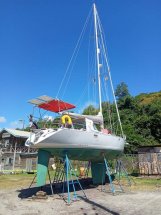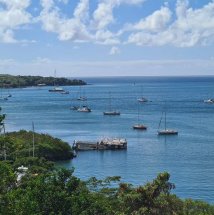Cruising is really maintenance in different places

We had a couple marina days in
Port Louis after Steve left us and, on the Saturday morning, absent mindedly
wandering up to the cafe, I was stopped by Dennis and Martha from Fishcake (ex
Cascais and Las Palmas) who had just sailed in from Tobago. We knew they had
made it to Barbados in 27 days from Las Palmas and were heading to Tobago, but
it was great to catch up again.
They had travelled from Prickly Bay by bus to deal with the immigration
formalities. On Sunday we were aiming to make
our way east towards St Davids Harbour so we agreed to meet the Fishcakes in
Clarkes Court Bay. We were
scheduled for a lift out and pressure wash to clean the undersides on Wednesday
early so needed to be off the hoist the previous night. We had a loose anode which necessitated
removing the folding propeller, and I wanted to see if we could get a new Delrin
top bearing made for the rudder post.
The rudder post had bumped from side to side (it seemed like 5mm but was
probably less than 1mm movement) since leaving Plymouth; I was sure it wasn’t
going to fail – the shaft is a 90mm diameter solid stainless rod, and the
bearing was huge but the movement was probably wearing the lower bearings and
seals. Leaving St Georges, we headed
south to round the island and halfway to Prickly Bay (PB) I happened to pick up
a Pan Pan (urgency) radio message from a yacht that had engine failure west of
us by five miles or so and were drifting toward Central America. This was fortuitus for them in a way
because we don’t have a cockpit speaker for the radio at present. They were clearly anxious, but the
weather was fine and since there was no response from any official quarter, we
responded to say we would try to assist. The caller on the radio was clear and
efficient and we located them about three quarters of an hour later and stopped
within hailing distance. By
this time the breeze had filled in from the northeast at 10-12 knots (from very
little earlier), so I suggested they hoist their headsail and beat north so they
could tack towards St Georges later, and we would standby and help them if they
ran out of wind closer to the shore.
The breeze and the swell was making me disinclined to try towing in the
open sea. They hoisted a very baggy
and poorly set headsail on a stay inside their furling headsail and set off –
slowly – not helped by the fact that they had two reefs in their main sail. They seemed very grateful to us
for standing-by. Their boat was bigger than ours and I would have liked them to
shake out the reefs but good manners prevented me from suggesting how they sail
their yacht, and as they had made it there from Trinidad, they were not
completely hopeless, but they were clearly not good sailors either. Anyway, to set an example we set full
sail and powered north after them and then had to heave- to and wait for them to
catch up. We suggested when
they should tack and they were happy to respond and we sailed together like this
for a good bit of the morning closing the land close to St Georges Harbour with
the wind holding and us heaving-to at intervals to let them catch up. We were just contemplating towing them
to an anchorage when they said they had requested a tow from the marina work
boat so we stood down and resumed our passage to Clarkes Court Bay. We heard later from Gabriel, a
Cornish shipwright on a Mevagissey lugger (the only lugger in PB – or probably
in the Caribbean for that matter), that he had done some work on their engine
and they were now heading for Martinique and the Pacific! After we had anchored in Clarkes
Court Bay we were able to help Dennis and Martha with some orientation such as
the best rum punch spots and the location of the second-hand boat bits treasure
trove. On Tuesday morning we left for St
Davids with an exploratory lunch time stop in the ‘hurricane hole’ of Port
Egmont. This was interesting
and would clearly be very sheltered but there was no public landing as the
entire bay was surrounded by private residences. On Wednesday and Thursday the lift and
maintenance went smoothly and we were able to bring our launch time on Friday
forward from pm to am. We also got
a new rudder bearing made by a German engineer called Dietmar who really wanted
us to drop the rudder out so he could measure the shaft accurately, but since it
weighs 200kg, I didn’t want to so, muttering in German he took measurements off
the exposed top of the shaft and turned up with a new bearing the next
morning. The bearing fitted with
that reassuring ‘sticky-sucky’ fit, and on the sail back, the steering seemed
smooth, quiet and knock -free. What
is it that Audi say: Werk
sprung derk teknic– or similar? I mentioned the sail back to PB
but forgot to say that on leaving the hoist, we set the main sail and then found
we had no throttle control of the engine.
We had forward and reverse in tick over but no way of increasing
revs. Dropping the mainsail we
anchored, still in St Davids, in no wind, and a quick look at the engine showed
that the throttle cable was OK at that end but to access the lever end was a
major dismantling which might have left us stranded so we decided to sail back
to Prickly Bay with access to chandlers and shops. The wind built as we reached the narrow
exit from St Davids, but the wind angle let us sail briskly out under main sail
and then bearing away we set some Genoa and with a clean bottom sailed quickly
down to PB.. We took the headsail off entering the bay and close reached up the
harbour (with sixty plus yachts at anchor) and finding a suitable space, tacked
into it. The wind was probably too
fresh to control the boat at tick over revs so we luffed into the spot and
dropped the anchor letting the wind set the chain and dig the anchor in. This
was an exercise I had taught students to do for just that situation but which I
had never had to do myself, for real, before. Anchored in PB when we arrived
were Linda and Peter on the junk-rigged Koka Chin who we last saw setting off
from Cabo Verde and who were just arrived from Tobago. The following day, Edward, Brian’s
diving buddy from the great Cascais anchor recovery project, also sailed in from
Tobago on Adela; he was single-handed. Everyone except us has been to
Tobago and is raving about it so if we get our new Hydrovane rudder, and the
throttle cable fixed, we are thinking of a round trip there ourselves in the
last half of February. When we finally broke into the
throttle lever control unit (much drilling and sawing of corroded stainless
screws in aluminium castings) we found the broken cable and were able to remove
it. Unfortunately, the nearest
replacement was at Budget Marine on St Marten and a DHL delivery, we found
today, would take a week to arrive.
There were not many options so we are resigned to being immobilised at
anchor in PB while we wait but with dinghy access ashore and jobs to do on the
boat to occupy us. I would like to
report that the flexible, 100W solar panel, I bought for the dinghy will fully
charge the battery of the electric motor from 50 % discharged in a day of good
sunlight. Tomorrow, February 7th is a
public holiday for Independence Day on Grenada and we are going into St Georges
by bus to see the fun and games of the celebrations.
|




